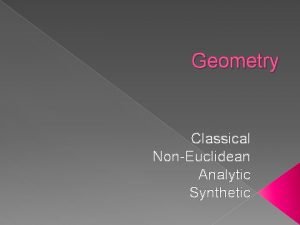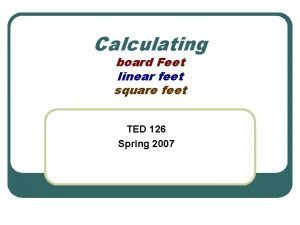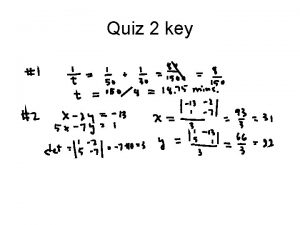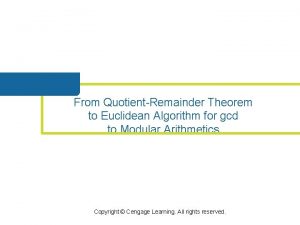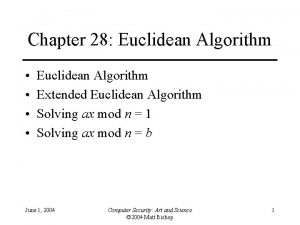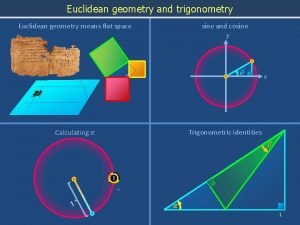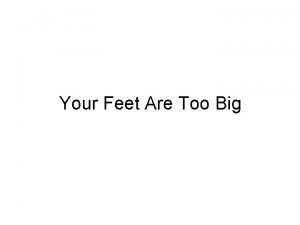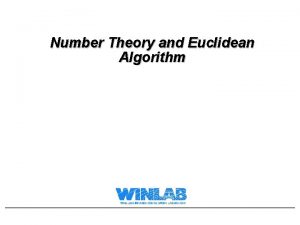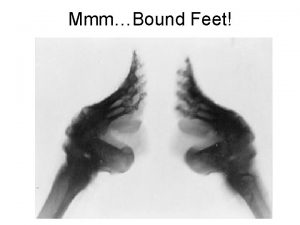Euclidean Geometry Revision Think on your feet Given



















- Slides: 19

Euclidean Geometry Revision

Think on your feet… Given is a list of Euclidean geometry concepts. You have 5 minutes to describe at least 10 concepts and also make use of an example to help one understand the concept. � Example: Scalene triangle – triangle with all sides and angles not equal. �

Euclidean geometry concepts: Parallel line, ü Perpendicular line, ü Obtuse angle, ü Acute angle, ü Complementary angles, ü Supplementary angles, ü Adjacent angles, ü ü Transversal line, ü Corresponding Angles, ü Alternate Angles, ü Co-interior angles, ü Isosceles triangle, ü Equilateral triangle

Lines – Parallel and Perpendicular Parallel lines • Lines which have the same gradient. • B Lines that are parallel ( II ) NEVER touch. D A c

Perpendicular lines � Lines which are at A right angles or 90º to 90º each other. � D Perpendicular lines (⊥) do touch each other at 90º angle. C B

Angles � Angle refers to the amount of rotation about the vertex.

Angles (Single) Acute Angle that is less than 90º � Right angle Angle that is 90º � Obtuse angle Angle that is more than 90º but less than � Straight angle Angle that is 180º � Reflex angle Angle that is 270º � Revolution angle Angle that is 360º � 180º

Angles (Pairs) Complementary Angles that add up to 90º, e. g. 30 and 60, 40 and 50. Supplementary Angles that add up to 180º, e. g. 120º and 60º, 145º and 35º. x 90º-x x 180º-x

Adjacent Angles � Angles that have a common vertex and a common arm and lie on opposite sides of the common arm (side). A B D C Angle ABD is adjacent to angle CBD.

When 2 lines intersect, we have…. � Adjacent supplementary angles e. g. a and b; c and d. a b c d � Vertically opposite angles e. g. a and c; b and d.

Corresponding Angles � Corresponding angles of parallel lines are equal. � F-shape � The positions of the angle correspond. x x

Alternating Angles Alternating angles of parallel lines are equal. � Z-shape � The pairs of angles on opposite sides of the transversal line. � y y

Co-interior Angles Co-interior angles of parallel lines are supplementary. � U-shape � The pair of angles on the same side of the transversal line. � x y

Triangles – Types of triangles Scalene triangle � The triangle has no sides or angles that are equal. Isosceles triangle � Triangle that has two sides that are equal. � The angles opposite the equal sides of an isosceles triangle are equal.

Triangle – Types of triangles Equilateral triangle � All sides and angles of the triangle are equal. � All angles in an equilateral triangles are always equal to sixty degrees. Right angled triangle � Triangle that has an angle that is equal to ninety degrees.

Rules and Theorems of triangles Sum of the interior angles of a triangle The sum of the interior angles of any triangle is 180º. 1. x 2. The exterior angle of a triangle is equal to the sum on the opposite interior angles. x y z x + y +z= 180º y z= x + y z

The theorem of Pythagoras � � The theorem states that in a right angled triangle, the square of the hypotenuse is equal to the sum of the squares of the other two sides. h² = x² + y²

Exercise 1 1. a. Solve for x, y and z in the following diagrams: b. 104º x 56º x 55º y y

c. A d. F 55º C y E B x D
 Tan chord theorem
Tan chord theorem Think big think fast
Think big think fast Euclidean
Euclidean Who is the father of analytic geometry
Who is the father of analytic geometry Passive sentence
Passive sentence Convert lineal feet to square feet
Convert lineal feet to square feet A little bird by aileen fisher
A little bird by aileen fisher Think fam think
Think fam think Lesson 2-5 reasoning in algebra and geometry
Lesson 2-5 reasoning in algebra and geometry Theory of structures
Theory of structures Electron domain geometry vs molecular geometry
Electron domain geometry vs molecular geometry Electron geometry vs molecular geometry
Electron geometry vs molecular geometry Give us your hungry your tired your poor
Give us your hungry your tired your poor If you scuff electrons from your feet while walking
If you scuff electrons from your feet while walking Nanny shine
Nanny shine Hapoy nod
Hapoy nod Euclidean algorithm gcd
Euclidean algorithm gcd Flat clustering vs hierarchical clustering
Flat clustering vs hierarchical clustering Euclidean algorithm
Euclidean algorithm Bitonic euclidean traveling salesman problem
Bitonic euclidean traveling salesman problem



